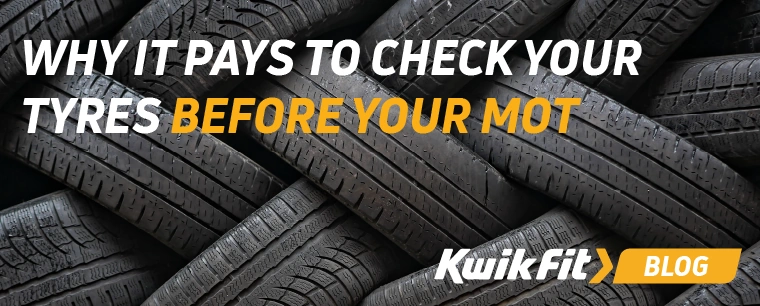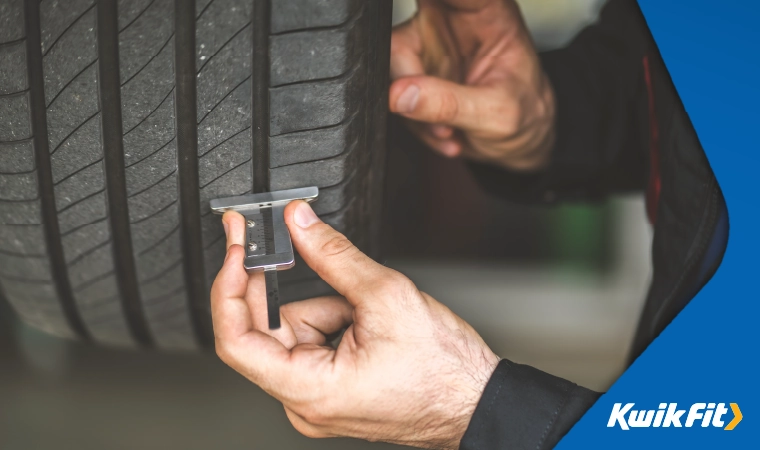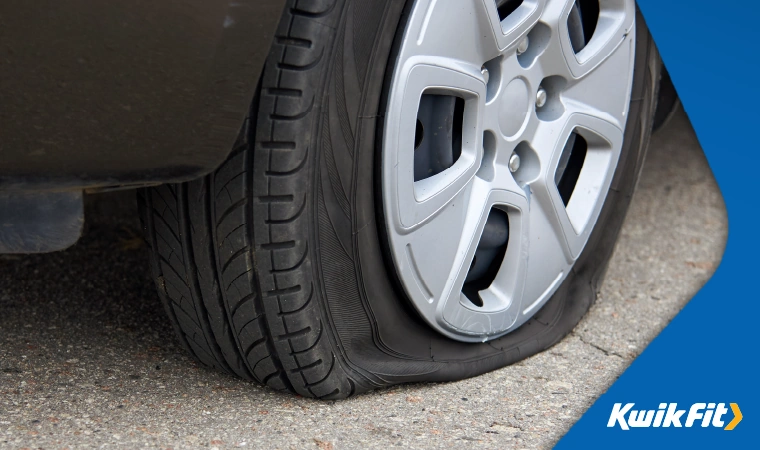Why It Pays To Check Your Tyres Before Your MOT
Jessica Bird | Wednesday 27th August 2025 10:15am

Did you know that over 15% of vehicles failed their MOTs between October and December of 2024?
What’s more, according to the DVLA, over 2.15 million vehicles failed their MOTs on tyre defects in 2023/4, rising significantly from 1.83 million failures in 2019/20.
With timely tyre checks and regular maintenance, a large proportion of these failures could have been avoided, saving motorists money and time (not to mention a lot of inconvenience).
From expanding your tyre lifespan to reducing repair costs, in this blog, we’ll explore why it pays to give your tyres a check before your MOT.
Tyres and your MOT
Tyres are in the top 5 reasons for MOT failure in the UK, behind common issues like faulty lighting, blown bulbs, brake issues, and suspension problems. That being said, very few drivers pay their tyres enough attention before their MOT, leaving themselves and other road users at an increased risk of accidents and fines.
Rest assured, checking the tread and condition of the tyres is part of the MOT, but since regular checks are so quick and easy to do, why would you wait until your annual test to be told your tyres are hazardous? In that scenario, your tyres could have been dangerous for the best part of a year - or even longer if you drive a new car.
What do they check on tyres on an MOT?
A qualified MOT tester will give all your tyres (including the spare) a thorough examination to make sure they are not damaged, have the legal minimum tread depth, be inflated enough, and match the correct type needed for your vehicle. Here’s a greater breakdown of the parts of your tyres that are checked during an MOT:
- Tread depth - Your tyres will be checked to ensure their tread depth is above the legal minimum of 1.6mm. This is done using a tread depth gauge. Any lower than 1.6mm and your car will fail its MOT, as your tyres will lack sufficient grip for safe traction with the road.
- Condition - The state of your tyres will be assessed to make sure they are safe to support the weight of your vehicle. Testers will look for any cuts or punctures and any bulging or damage to the sidewall. Driving with damaged tyres, especially at high speeds, significantly increases the risk of blowouts or punctures, endangering your passengers and other road users.
- Size & type - The tester will assess whether your tyres match the manufacturer’s recommended specifications for your make and model of vehicle. This includes checking the size, load rating, and speed rating.

Can you fail an MOT because of tyres?
Yes, your vehicle can easily fail its MOT on account of its tyres. Below is a list of tyre scenarios that could cause an MOT failure in the UK. You’ll likely fail your MOT if…
- Your tyres are below the legal minimum tread depth of 1.6mm.
- The internal cords or ply of your tyres are visible through wear or cuts.
- There’s serious damage to your tyres in the form of sidewall damage, cuts, and bulges.
- Your tyres are unsuitable for your vehicle (EG: mixing radial and cross-ply types on the same axle).
- The load rating or speed rating of your tyres does not match the manufacturer’s specification.
- Your tyres are not fitted correctly (EG: directions tyres fitted the wrong way round)
- There are objects embedded in your tyre, and it is deemed unsafe.
- Your tyres have valve defects that risk losing air pressure.
- Your tyres are significantly under- or over-inflated.
If your car fails its MOT, you can get a free MOT retest under some circumstances. Find out more on the Kwik Fit MOT retest page.
Is a pre-MOT tyre check worth it?
If you’re looking to reduce wasted time and money but gain peace of mind, then, yes, pre-MOT tyre checks are definitely worth it. Here are some of the reasons why it pays to keep an eye on your tyres between MOTs:
- Lower your risk of MOT failure. By monitoring and fixing any tyre issues in advance, you rule out the risk of failing your MOT on tyre-related issues.
- Save yourself some money. Checking your tyres regularly helps identify minor issues before they develop into more expensive repairs.
- Ensure your car is safe. Getting regular tyre checks from professionals is a surefire way to guarantee peace of mind that your vehicle is always road-ready.
- Avoid wasting time. A quick pre-MOT check is much less time consuming than having to book in repairs after your car fails on account of poorly-maintained tyres.

Can tyres wear out before a car's first MOT?
Currently, all cars require their first MOT when the vehicle reaches 3 years of age (with the exception of taxis, which must be tested after 1 year).
That being said, it’s important to remember that your tyres’ tread depth can easily be worn to below legal limits within three years and are vulnerable to damage at any time as a result of road debris and potholes.
And clearly, many drivers continue to use tyres that are overly worn or damaged, only replacing these when they have no choice, for example, following an MOT failure.
It’s essential to keep up with tyre maintenance and avoid nasty surprises when it comes to your first MOT. Regular servicing from experts like Kwik Fit can spot and treat any issues before they evolve into serious problems. Similarly, free tyre checks are an excellent way to gain peace of mind that your treads and sidewalls will live to fight another day!
ACT to ensure your tyres pass an MOT
Carrying out routine tyre maintenance checks is simple and needn’t take more than a few minutes every month. Struggling to remember your quick tyre checks? Let’s make it simple with the ACT acronym:
Air pressure
Always make sure your tyre pressure is at the correct level as per the manufacturer’s recommendation. You can find your recommended air pressure in your vehicle handbook or by using our pressure checker tool.
Condition
Make sure your tyres don’t show any signs of irregular wear or damage such as bulges, lumps, exposed cords or any cuts.
Tread
A simple way to check to see whether your tyre tread depth exceeds the minimum legal limit of 1.6mm is to use the 20p method. Simply place a 20p piece inside the main tread groove of the tyre and make sure your eyeline is level with the tyre. If the outer band of the 20p piece is visible, your tread is either nearing or beyond the legal limit so have them checked as soon as possible.
More checks to help you pass your MOT
Tyres aren’t the only common reason why drivers fail their MOT. Here are some further simple checks recommended by the DVSA to help you avoid an MOT fail, or worse, a serious accident.
Make sure that:
- The vehicle brakes smoothly and doesn’t pull to one side when braking
- Your headlights and other lights work. Lights are the most common cause of MOT failures which can be easily avoided by checking all lights beforehand. Give them a tap to check they’re not loose or damaged and check the colours are correct and match
- Your windscreen washers work and your wipers show no signs of wear or splitting
- The driver’s view of the road is not obstructed. Items such as stickers, sat nav mounts, toys or air fresheners that are seen to be an obstruction can result in a fail
- Any dashboard warning lights such as the TPMS fault indicator are not illuminated
Find out more about how to conduct these pre-MOT checks yourself in our handy guide.
Trust Kwik Fit for MOT & tyre help today
If you’re concerned about the state of your tyres in advance of your next MOT, get in touch with the experts at your local Kwik Fit and they can point you in the right direction.
Any facts, figures and prices shown in our blog articles are correct at time of publication.
Featured Articles
Is it Illegal to Drive With One Headlight?
Saturday 19th July 2025
Wondering if it’s illegal to drive with one headlight? Learn about the safety risks and penalties of illegal blown bulbs and why you should fix them promptly.
Air Con in EVs & Hybrids: Experts Answer Your Questions
Monday 30th June 2025
Does air con drain EV batteries? Can you use the air con while charging an electric car? Find out the answers to these questions & more from Kwik Fit’s experts.
Why Is Your Car Making a Noise? Fixes & Tips
Friday 13th June 2025
When your car starts making unexpected noises, it can certainly be quite disconcerting; it may be nothing to worry about, but here’s what you need to know.









